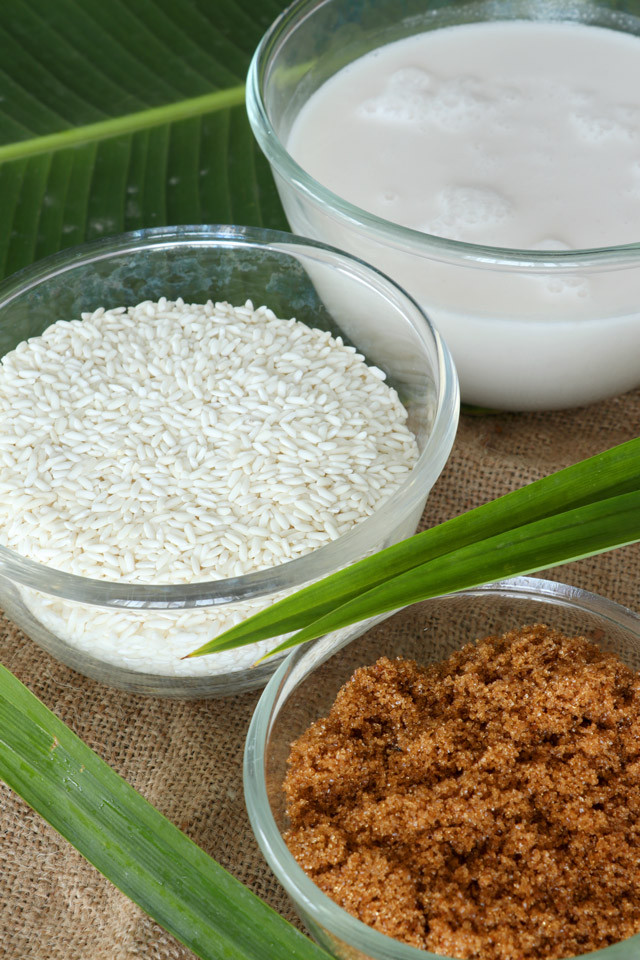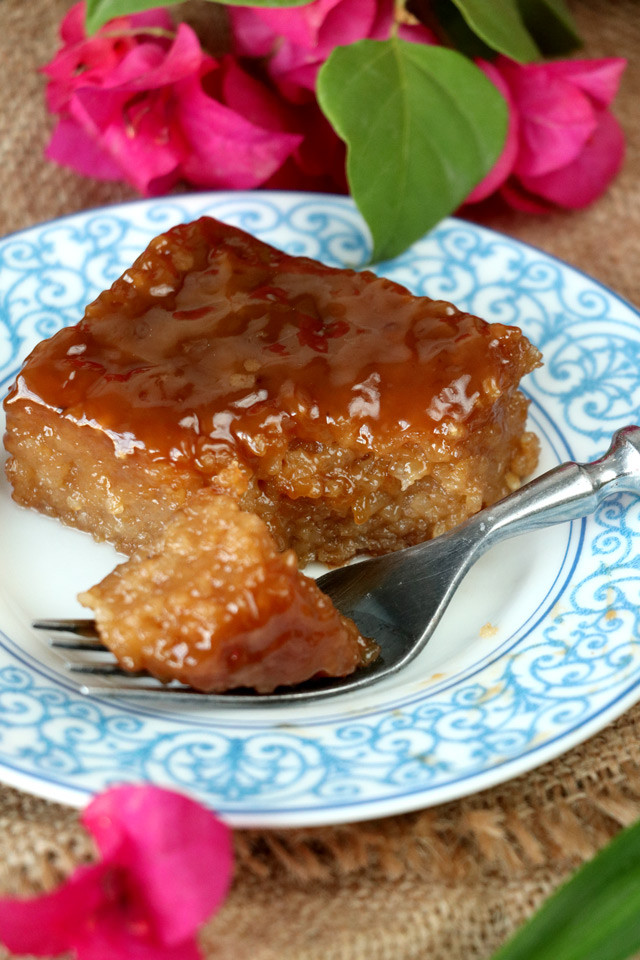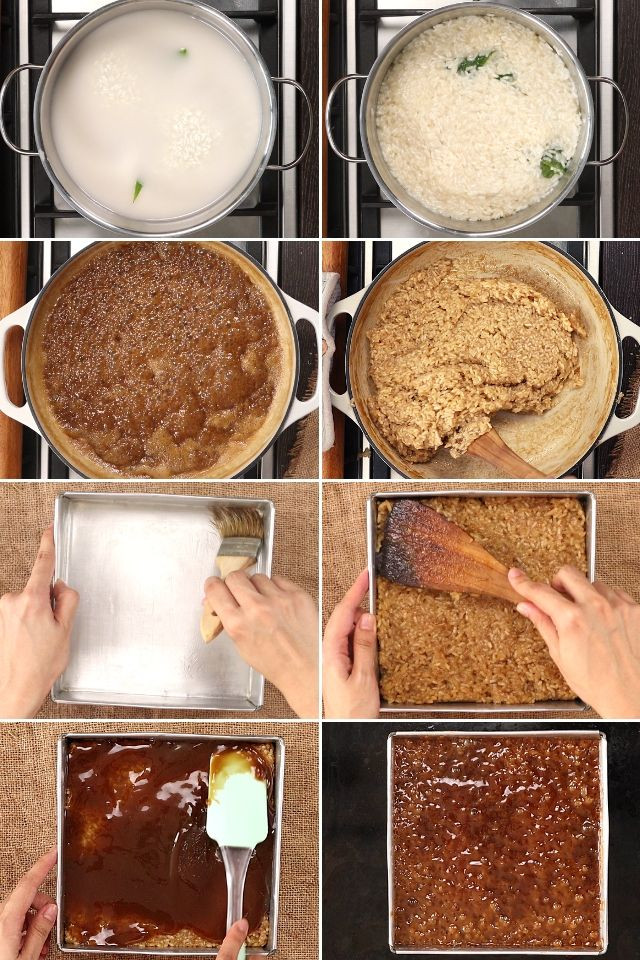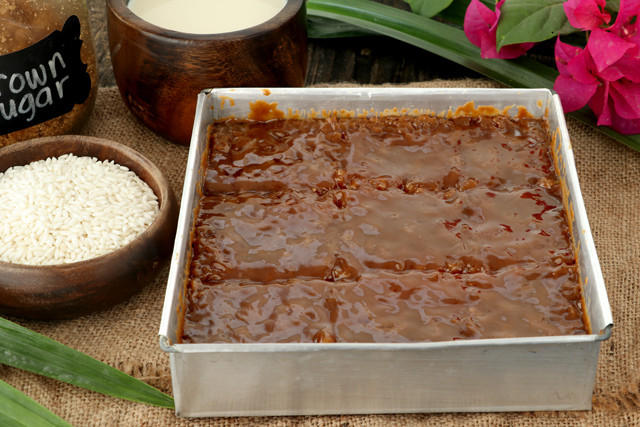Get that perfect sticky chewiness every time with this easy Biko recipe. Topped with a luscious coconut caramel sauce known as latik, this Filipino rice cake is a guaranteed crowd-pleaser.
 Close-up of Biko, a Filipino sticky rice cake with a glossy latik syrup topping, showcasing its chewy texture and inviting caramel color.
Close-up of Biko, a Filipino sticky rice cake with a glossy latik syrup topping, showcasing its chewy texture and inviting caramel color.
What is Biko? Unveiling the Filipino Sticky Rice Cake
Biko (pronounced bee-koh) is a beloved Filipino delicacy, a type of rice cake locally known as ‘kakanin’. At its heart, biko is made from glutinous rice cooked to perfection in creamy coconut milk and sweetened with rich brown sugar. What truly elevates biko is its crowning glory: latik. Latik is a decadent topping derived from coconut milk, transformed into either delightful curds or a smooth, flowing syrup. Traditionally, biko is presented on a bilao, a circular woven bamboo tray, lined with fragrant banana leaves brushed with coconut oil. This makes it not just a treat but a centerpiece, especially popular during special Filipino occasions like birthdays, family reunions, and town fiestas.
Across the Philippines, biko is cherished and recognized by various names. In some regions, you might hear it called Bibingkang Malagkit, while in the Southern Tagalog areas, it’s known as Sinukmani. For many Filipinos, like those who grew up simply calling it kalamay, biko is more than just a dessert; it’s a taste of home and a reminder of cherished traditions.
 The four essential ingredients for making Biko are beautifully arranged: glutinous rice, canned coconut milk, dark brown sugar, and fresh pandan leaves.
The four essential ingredients for making Biko are beautifully arranged: glutinous rice, canned coconut milk, dark brown sugar, and fresh pandan leaves.
Essential Ingredients for Homemade Biko
Crafting this Filipino delicacy requires just a handful of core ingredients: glutinous rice, coconut milk, water, and brown sugar. To create the signature latik topping, you’ll need coconut milk and brown sugar again. Some variations also incorporate pandan leaves to infuse an aromatic layer into the rice, and a touch of vanilla extract can enhance the latik syrup.
The type of brown sugar you choose plays a significant role in the final color and flavor of your biko. For a deeper, richer brown hue, opt for dark brown sugar or muscovado. Keep in mind that sweetness levels in brown sugar can vary, so adjust the quantity to match your personal preference. Incorporating pandan leaves during the rice cooking process adds a subtle, fragrant complexity. A hint of vanilla extract in the latik syrup provides an extra layer of deliciousness, creating a truly irresistible coconut caramel.
 A serving of Malagkit na Kalamay or Biko is presented on a white plate, showcasing its glossy caramel topping and inviting texture, ready to be enjoyed.
A serving of Malagkit na Kalamay or Biko is presented on a white plate, showcasing its glossy caramel topping and inviting texture, ready to be enjoyed.
Mastering the Art of Biko Making
There are several approaches to cooking biko, each yielding slightly different results. One common method involves pre-cooking the glutinous rice as you would regular rice, and then combining it with the coconut caramel later. Another, quicker method, shared by a friend, is to simply combine all biko ingredients in a rice cooker for a convenient snack.
This recipe focuses on a more traditional technique. Instead of just boiling the sticky rice in plain water, we’ll cook it in a blend of coconut milk, water, and pandan leaves. This allows the rice grains to absorb the fragrant coconut milk from the start, building layers of flavor right from the base.
 Step-by-step photo series demonstrating how to make sticky rice cake, from cooking the rice to layering it with latik and baking until golden brown.
Step-by-step photo series demonstrating how to make sticky rice cake, from cooking the rice to layering it with latik and baking until golden brown.
Tips for the Chewiest Biko and Perfect Latik Topping
While making biko is straightforward, a few key pointers can ensure your success in achieving that signature chewy texture and avoiding common pitfalls like a mushy or undercooked result.
- Control the Water When Steaming Rice: Be mindful of the water quantity when initially steaming the glutinous rice. It’s intentionally undercooked at this stage. Overdoing it can lead to broken grains later, resulting in a paste-like consistency rather than distinct, chewy grains.
- Gentle Stirring is Key: In the initial rice cooking phase, occasional gentle stirring is acceptable to prevent scorching at the bottom. However, avoid excessive stirring, as it can also contribute to a mushy texture.
- Folding Rice into Latik Syrup: When incorporating the cooked rice into the latik syrup, gently fold to ensure even coating. Allow the rice to absorb the liquid, stirring intermittently. Continue this process until the grains are fully cooked, expanded, and wonderfully sticky.
- Baking Time and Latik Thickness: The baking duration for biko depends on the thickness of the latik caramel topping. A thicker layer may require more than the standard 20-30 minutes. The biko is ready when the latik becomes bubbly and loses its gooey appearance.
 Freshly cooked Kalamay na Malagkit, or Biko, is showcased, highlighting its appealing texture and the rich, caramelized latik topping that makes it so irresistible.
Freshly cooked Kalamay na Malagkit, or Biko, is showcased, highlighting its appealing texture and the rich, caramelized latik topping that makes it so irresistible.
Printable Recipe
Print Recipe
Biko Recipe (Filipino Rice Cake)
Yields: 9 squares
Prep time: 5 minutes
Cook time: 1 hour
Total time: 1 hour 5 minutes
Ingredients:
For the Rice:
- 2 cups glutinous rice, washed and drained
- 1 cup canned coconut milk
- 1 cup water
- 2 pandan leaves
For the Latik Syrup:
- 2 cups canned coconut milk (See Note 1)
- 1 cup dark brown sugar, packed
- 1 teaspoon vanilla extract (optional)
- Vegetable or coconut oil, for greasing
Instructions:
- Prepare the Pan: Generously grease an 8×8-inch square baking pan with vegetable or coconut oil and set aside.
- Cook the Rice: In a large pot over medium heat, combine 1 cup coconut milk and 1 cup water. Add the glutinous rice and pandan leaves. Bring to a simmer, then reduce heat to low, cover, and cook until all liquids are absorbed. The rice should be partially cooked at this stage, slightly soft but with some chalkiness in the center. If too undercooked, add a little more water (start with ¼ cup) along the edges.
- Make the Latik Syrup: While the rice cooks, prepare the latik syrup. In a large pan, combine 2 cups coconut milk and 1 cup dark brown sugar. Add vanilla extract if desired. Cook over medium heat, stirring constantly until the liquid reduces into a thick, deep brown caramel syrup. Reduce heat to very low.
- Combine Rice and Syrup: Reserve ½ cup of the latik syrup for topping. Add the cooked rice (discard pandan leaves) to the pan with the remaining latik syrup. Gently fold the sticky rice into the syrup until completely coated. Cook, stirring occasionally, until the rice absorbs the syrup and becomes sticky, but individual grains are still visible with some white parts remaining.
- Bake: Transfer the rice mixture to the greased pan and spread evenly. Pour the reserved latik syrup over the top and spread evenly. Bake in a preheated oven at 350°F (180°C) for 20-30 minutes, or until the latik is bubbly and slightly reduced.
- Cool and Serve: Remove from oven and let cool completely. Cut into squares and serve.
Recipe Notes:
- Note 1: One can of coconut milk is typically 400ml. This recipe uses 2 cans total: 1 cup (approx. 240ml) for the rice and the remaining (approx. 560ml) for the latik syrup.
Nutrition Information:
Calories: 455kcal
Carbohydrates: 66g
Protein: 5g
Fat: 20g
Saturated Fat: 18g
Sodium: 24mg
Potassium: 291mg
Fiber: 3g
Sugar: 28g
Vitamin C: 2mg
Calcium: 41mg
Iron: 2mg

